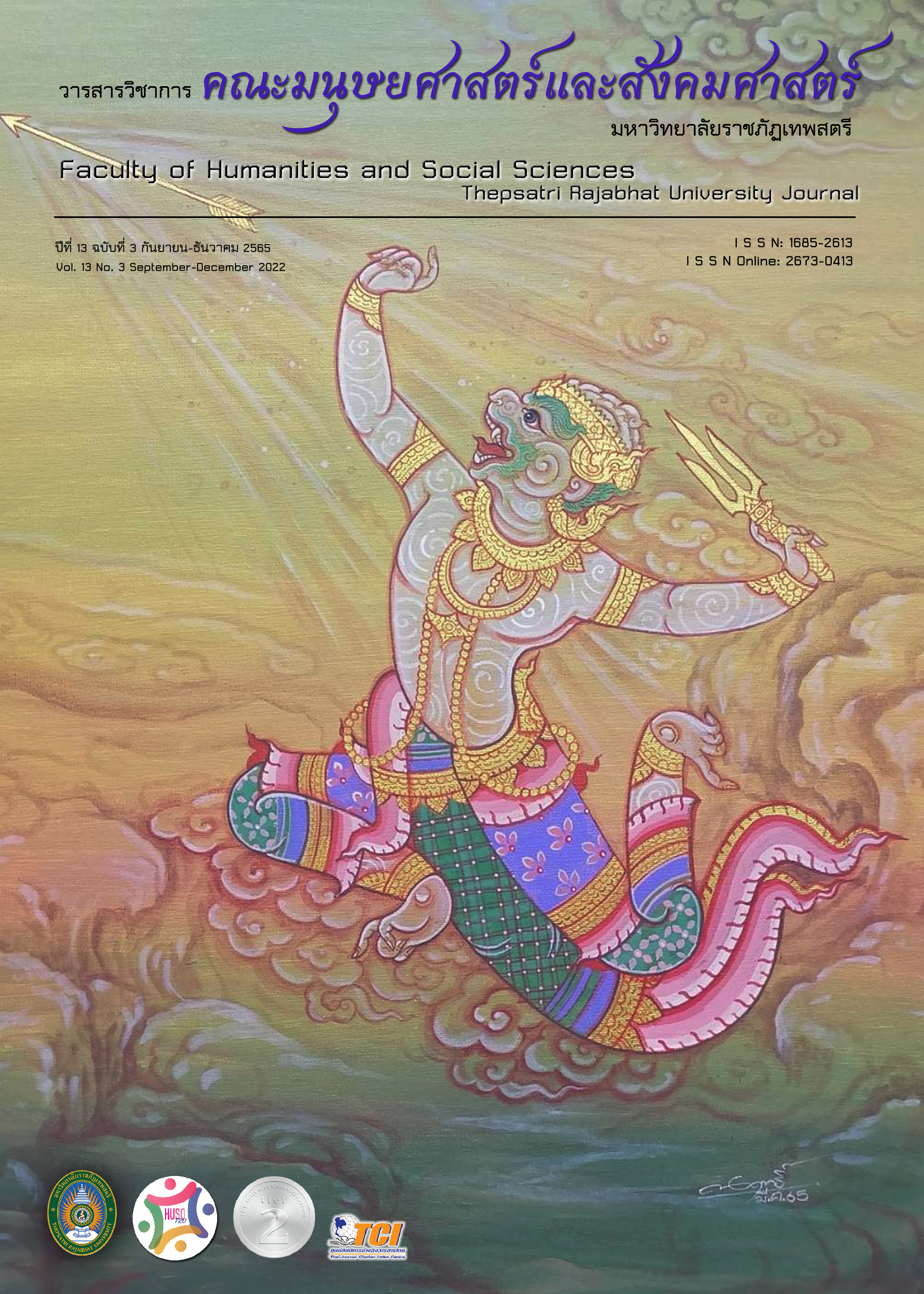Jakae Playing Techniques in Thai Contemporary Music
Main Article Content
Abstract
This research was aimed to study Jakae playing techniques in Thai contemporary music ensembles. The data collection employed in the study were documentary research, field study, expert interviews, audiovisual media, records, and music notation for Jakae. The research instruments included the structured and unstructured interviews to explore the concepts of Jakae playing, Jakae playing techniques, and solutions to limitations. After that, data analysis was conducted using the Jakae playing theory.
The findings revealed that: first, Jakae playing concept: 1) Jakae is played in traditional patterns and only the accompanied instruments are changed, but the original playing techniques are used. 2) A specific song is selected based on its compatibility with the sound of a traditional Jakae by which a performer often maintains the original techniques together with adjusting rhythms to follow the conductor’s instructions. 3) The melody lines are created to be consistent with a variety of Modes. Second, three playing techniques are found: (1) Adapting playing techniques from those of other string instruments, (2) Adapting playing techniques from different music instruments of other countries, and (3) Changing the scales to create new techniques. The last, three aspects regarding solutions to limitations are discussed: Jakae performers, Jakae, and songs; 1) Jakae performers should be experienced in playing the instrument using both the traditional and special techniques. They should be skillful in applying different techniques. 2) The structure of sound frets of Jakae is unique, so it should not be added with too many intervals to maintain sound clarity. Using semi-tone scales in some frets can create unfamiliar tunes. Jakae performers should explore a variety of improvisation and its suitability for melodies. 3) The selection of songs should concern their consistency with the sound of Jakae and other accompanied instruments in the ensemble.
Downloads
Article Details

This work is licensed under a Creative Commons Attribution-NonCommercial-NoDerivatives 4.0 International License.
The content and information presented in articles published in the Academic Journal of the Faculty of Humanities and Social Sciences, Thepsatri Rajabhat University, are solely the opinions and responsibilities of the respective authors. The editorial board of the journal neither necessarily agrees with nor assumes any responsibility for such content in any manner whatsoever.
All articles, information, content, and images published in the Academic Journal of the Faculty of Humanities and Social Sciences, Thepsatri Rajabhat University, are the copyright of the journal. Any person or organization wishing to reproduce, disseminate, or otherwise utilize all or any part thereof must obtain prior permission from the Academic Journal of the Faculty of Humanities and Social Sciences, Thepsatri Rajabhat University.
References
ณัฐชยา นัจจนาวากุล. (2563, กรกฎาคม - ธันวาคม). พลวัตการเปลี่ยนแปลงแบบแผนดนตรีไทยสู่ดนตรีไทยร่วมสมัย. วารสารศิลปกรรมศาสตร์ จุฬาลงกรณ์มหาวิทยาลัย, 7(2), 40 - 52.
ดวงเด่น บุญปก. (2562, มกราคม - มิถุนายน). อัตลักษณ์และสัญลักษณ์ของผ้าไหมพื้นเมืองกลุ่มเขมรถิ่นไทย. วารสารวิชาการคณะมนุษยศาสตร์และสังคมศาสตร์ มหาวิทยาลัยราชภัฏเทพสตรี, 10(1), 91 - 102.
นิรุตร์ แก้วหล้า. (2563, พฤษภาคม - สิงหาคม). วัฒนธรรมดนตรีชาติพันธุ์สู่การสร้างสรรค์ดนตรีร่วมสมัย: กรณีศึกษากลุ่มชาติพันธุ์ ม้ง ลีซู ลาหู่ ดาระอั้ง ปกาเกอะญอ. วารสารวิจัยราชภัฏเชียงใหม่, 21(2), 197 - 218.
เพชรลดา เทียมพยุหา, มานพ วิสุทธิแพทย์, และกาญจนา อินทรสุนานนท์. (2557, มกราคม - มิถุนายน). การศึกษาดนตรีร่วมสมัย กรณีศึกษาวงกำไล. วารสารศิลปกรรมศาสตร์ มหาวิทยาลัยขอนแก่น, 6(1), 69 - 88.
วิพล นาคพันธ์. (2553). เพลงลูกกรุง. สืบค้น ธันวาคม 7, 2564, จาก https://www.gotoknow.org/posts/tags/.
_______. (2559). เพลงความรักเจ้าขา. สืบค้น ธันวาคม 7, 2564, จาก https://www.gotoknow.org/posts/427234.
บุคลานุกรม
ขำคม พรประสิทธิ์. (2564, ธันวาคม 21). หัวหน้าศูนย์เชี่ยวชาญวัฒนธรรมดนตรีไทย คณะศิลปกรรมศาสตร์ จุฬาลงกรณ์มหาวิทยาลัย. สัมภาษณ์.
_______. (2564, ธันวาคม 26). หัวหน้าศูนย์เชี่ยวชาญวัฒนธรรมดนตรีไทย คณะศิลปกรรมศาสตร์ จุฬาลงกรณ์มหาวิทยาลัย. สัมภาษณ์.
ประสาร วงศ์วิโรจน์รักษ์. (2564, กันยายน 2). นักวิชาการอิสระด้านดนตรีไทย. สัมภาษณ์.
_______. (2564, กันยายน 5). นักวิชาการอิสระด้านดนตรีไทย. สัมภาษณ์.
สุธารณ์ บัวทั่ง. (2564, ตุลาคม 26). นักวิชาการอิสระด้านดนตรีไทย. สัมภาษณ์.


